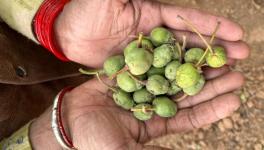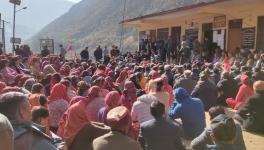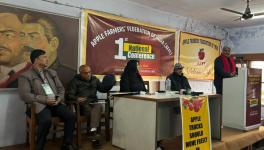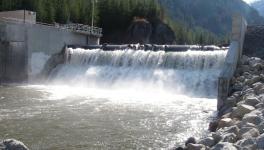Is Asking the Army To Cut Down Apple Trees The Only Way To Remove Encroachments?

Army called to cut down apple trees in Himachal Pradesh as part of crackdown on illegal encroachments. (Image Courtesy: The Indian Express)
“The Army will be called to cut down the apple trees in Shimla district”, said the headlines of regional newspapers in North India a few days ago. Why the Army? Isn’t the Army supposed to maintain the nation’s security? So, is this a security matter? Also, it is ironic that people in the national capital of Delhi are fighting to protect the trees from felling for construction of apartments, whereas in Shimla, the Army is being called in to cut down trees.
The Himachal Pradesh High Court in a recent order on encroachment on forest land has asked the special investigation team (SIT), formed to cut down apple trees, to take the help of the ‘eco task force’- a regiment of the Indian Army. Strangely, the eco-task force is meant to plant trees in arid regions, but in Shimla they have been called to cut down apple trees. Incidentally, it has been learnt that through a communiqué to the district collector that the Army has expressed its inability to assist the SIT, vehemently stating that the job of the task force is to plant trees, not to chop them down. They have also stated that they are not equipped with the logistics to cut trees. However, only time will tell how long the Army will be able to resist the HC order. But one thing is for sure, that the HC is bent upon removing encroachments from forest land by cutting down apple trees, which it believes have been planted after cutting down natural forests.
Meanwhile, there are mixed reactions to this order. Whereas a section of the environmentalists have supported the court’s order to remove encroachments in the forest region of Himachal Pradesh in the form of apple orchards, others have opposed it.
Baldev Chauhan, a senior journalist and a supporter of this decision, has welcomed the decision. According to him, all forest land should be free from encroachments. There is another group of environmentalists who have termed this order as “childish” as they feel that fruit-bearing trees should not be cut. According to them, the trees could have been protected and encroachments could have been fenced and handed over to the forest department. Cutting down trees is unscientific and anti-environment, they say. The Himachal Kisan Sabha (HKS) has also expressed displeasure over this decision and has asked the government to find an alternate way to protect the apple trees.
The depth of the problem
Land happens to be an important issue in the tiny mountain state of HP, but there very scarce land is available for ploughing. More than 66% of land is under forests and just 10% is used for agricultural purposes.
According to Sanjeev Bhushan, senior advocate of the HC, the problem lies in the comprehension of the status of land. The question is whether the said land is revenue or forest land? According to him, the 1954 HP State Land Revenue Act was amended in 2000 and section 163 (A) was incorporated, which allowed for the adverse possession of the land. This meant that if the land is possessed by an individual for a period of 30 years, then its deemed as transferred to the possessor’s name. But this was limited to 20 bighas (1.66 hectare) of the total land in possession. This meant, that if ‘one’ had 10 bighas and another 10 was encroachment/ possession for more than 30 years, all 20 bighas would be regularised and registered in the occupier’s name. More than that land cannot be regularised.
Realising that a large number of families in the state were sustaining their agricultural operations on such land, the then BJP government in the state decided to regularise these encroachments. Dr. Rajan Sushant was the revenue minister during that period (2002). The BJP government asked farmers to file their claims on a simple paper with an affidavit of Rs 50. These claims were made under section 163 (A) of the Land Revenue Act- adverse possession provision. Interestingly, 1,67,339 forms/claims were submitted to the revenue department.
The demands made were part of the natural corollary, as land in the past (during Dr. Parmar’s period-the first Chief Minister of HP), was distributed either through ‘Nau Taur’ (breaking new land-where 5 bighas was distributed to the landless) or through the land reforms. It was prudently presumed by the farmers that the land which they had been occupying for a reasonable period would also get regularised in due course of time. However, this did not apply to those having large encroachments.
This move of the BJP government was opposed and challenged in the High Court by Hridesh Arya and Poonam Gupta (wife of Justice Deepak Gupta of the Supreme Court who was then a practicing advocate in HP), in the year 2002. There was an interim order by Justice Ms. Kamlesh Sharma, the then Chief justice of HP, terming the process followed by the government as correct, saying that it should continue. However, a rider was attached that the land title should not be transferred during that period till the case is pending. Similarly, Justice Lokeshwar Panta upheld the process and asked the government to frame the rules.
So, why call the Army?
If that is the case, then why under the same petition, have the courts summoned the Army to chop down apple trees? According to Professor Rajender Chauhan (retired teacher from HP university), land, which is the state subject and should be under the revenue department, has been wrongly transferred with the government order of 1956. According to that order, all land (other than individually owned land) –which is fallow, untilled, un-demarcated, untitled etc., was termed as forest land. According to Chauhan, the state government could still lay its hand on such land for distribution and settlement as forest was under the state list.
In fact, ‘Nau taur’ land distribution before 1980 was settled in the name of the beneficiaries, and majority of the land distributed was under the title of forest land (treeless). However, after 1980 the forest was transferred into the concurrent list and the state governments across the country lost their capacity to use such (forest) land for any other purpose. Due to the 1956 order, even treeless land used by the people got transferred into the category of forest and, hence, could not be distributed de jure. Though, de facto the land was in the possession of the people.
Ambiguous land status
It is in this background that the dispute over land continues and its status is still ambiguous. According to advocate Rajneesh Maniktala from HP High Court, this land should be termed as revenue land, and government must revoke the 1956 notification, thus, defining that the forest land and all fallow land, land without trees etc., should be with the state government. But there is another set of lawyers who term the decision of the court as justifiable and stand behind this order. According to Shravan Dogra, former advocate general of HP, the court must first decide the merit of the petition and then pass an order on the encroachments. The court instead is passing interim orders to cut down apple trees without deciding on the merits of the case.
According to him, the trial on the violation of section 163 (A) should have been done in a summary form and adequate time should have been given to the farmers to defend themselves in the lower courts. Instead, the court has asked the forest department to proceed under the Public Premises (PP) Act, where the magistrate is a forest official. The poor farmer is asked to tender a written statement that he has wrongly encroached on forest land and that ‘he’ shall vacate the premises wilfully. The execution of cutting down of trees is taking place through such an order. The right of the offender –if at all he is an offender -- is being denied. The courts have overlooked the procedure.
How big are the encroachments?
According to newspaper reports, there are a few families who have large sized encroachments in the hill state. According to Robin Chauhan from Kotkhai, large scale forests were chopped down to plant apple trees and a few families have encroached on more than 200 bighas (12.5 bighas =1 hectare). However, this claim is staunchly denied by farmers’ organisations. According to them 95% are small and marginal farmers. In an affidavit filed in the high court by the SIT, comprising the police and the forest officials, only 13 such families who have large encroachments could be traced. Not a single one with more than 100 bighas was found. However, in another list submitted by them, they contested their claim and gave a list of just two such encroachers with more than 100 bighas.
What is the alternative?
Is cutting down apple trees the only alternative to remove encroachments? Not many support this solution. Instead, fencing of the land can be an immediate intervention. The Army should not be asked to chop down the trees.
There is another narrative advocated both by the farmer organisations and a section of environmentalists. According to them, Himachal should be declared as a forest state. There are a few districts like Kullu where 90% land is forest land. Similarly, the two tribal districts of Kinnaur, and Lahaul & Spiti are predominantly forest land. Hence, the rights of the forest dwelling communities should accrue to the wide mass of the hill state.
Historically, the communities living in Himachal are forest dwellers. Their rights have even been recorded by the British. Infamous rights like the timber distribution (TD) rights for construction of houses, timber for fuel and rights for fodder etc., were all registered. The Waziwul-urje is another form of recorded rights of the different communities of the mountains. Another important right was the ‘Naksha-Bartan’ right, which listed the rights of the forest dwelling communities. There are a number of such rights registered since ages. However, the FCA Act of 1980 completely negated all these rights and has thrown the farming community, which was inalienably linked to the forests, out of their legitimate rights and domain.
This does not mean that all big encroachments should be regularised. But, a better way of intervention and a better solution can always be offered instead of just cutting down the apple trees.
Get the latest reports & analysis with people's perspective on Protests, movements & deep analytical videos, discussions of the current affairs in your Telegram app. Subscribe to NewsClick's Telegram channel & get Real-Time updates on stories, as they get published on our website.
























